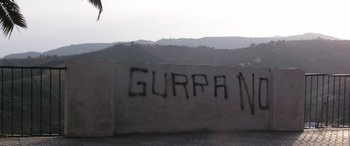
Radical and political graffiti |
Graffiti often has a reputation as part of a subculture that rebels against authority, although the considerations of the practitioners often diverge and can relate to a wide range of attitudes. Some see graffiti not only as an art but also as a lifestyle. It can express a political practice and can form just one tool in an array of resistance techniques. One early example includes the political punk band Crass, who conducted a campaign of stencilling anti-war, anarchist, feminist and anti-consumerist messages around the London Underground system during the late 1970s and early 1980s.
The developments of graffiti art which took place in art galleries and colleges as well as "on the street" or "underground", contributed to the resurfacing in the 1990s of a far more overtly politicized art form in the subvertising, culture jamming or tactical media movements. These movements or styles tend to classify the artists by their relationship to their social and economic contexts, since graffiti art remains illegal in many forms, in most countries. Contemporary practitioners, accordingly, have varied and often conflicting practices. Some individuals, such as Alexander Brener, have used the medium to politicise other art forms, and have used the prison sentences forced onto them as a means of further protest. The practices of anonymous groups and individuals also vary widely, and practitioners by no means always agree with each others' practices. Anti-capitalist art group the Space Hijackers, for example, in 2004 did a piece about the contradiction between the capitalistic elements of Banksy and his use of political imagery. As an added complication to this picture, some artists receive a combination of government funding as well as commercial or private means, like irrational.org who recently coined the term Advert Expressionism, replacing the word Abstract for Advert, in Clement Greenberg's essay on Abstract Expressionism. On top of the political aspect of graffiti as a movement, political groups and individuals may also use graffiti as a tool to spread their point of view. One can label this as "propaganda graffiti". This practice, due to its illegality, has generally become favored by groups excluded from the political mainstream (e.g. far-left or far-right groups) who justify their activity by pointing out that they do not have the money -- or sometimes the desire -- to buy advertising to get their message across, and that a 'ruling class' or 'establishment' control the mainstream press, systematically excluding the radical/alternative point of view. This type of graffiti can seem crude, for example fascist supporters often scrawl swastikas and other Nazi images. Because of the strong associations between Nazi images and racial violence, many see this type of graffiti as tantamount to a threat of violence, and thus some would classify it as a form of terrorism. Both sides of the conflict in Northern Ireland produce political graffiti. As well as slogans, Northern Irish political graffiti include large naïve wall paintings, referred to as murals. Along with the flying of flags and the painting of kerb stones, the murals serve a territorial purpose. Artists paint them mostly on house gables or on the Peace Lines, high walls that separate different communities. The murals often develop over an extended period and tend to stylization, with a strong symbolic or iconographic content. Loyalist murals often refer to historical events dating from the war between James II and William III in the late 17th century, whereas Republican murals usually refer to the more recent troubles. Following the recuperation of 'Post-Graffiti', illegal fly-posting provides another popular visual method by which political groups seek to spread their message and advertise their events. In the UK, posters advertising the February 15, protests against the 2003 invasion of Iraq stayed visible months after the event and may remain for years. The British Army notoriously had to respond to the popularity of anti-war graffiti website Bomblondon.com with the photographic exhibition showing what military graffiti says in and about Iraq in 2005 called "THE WRITING ON THE WALL". |
© Copyright tagcltd.com All rights reserved. Unauthorized duplication in part or whole strictly prohibited by international copyright law. |
